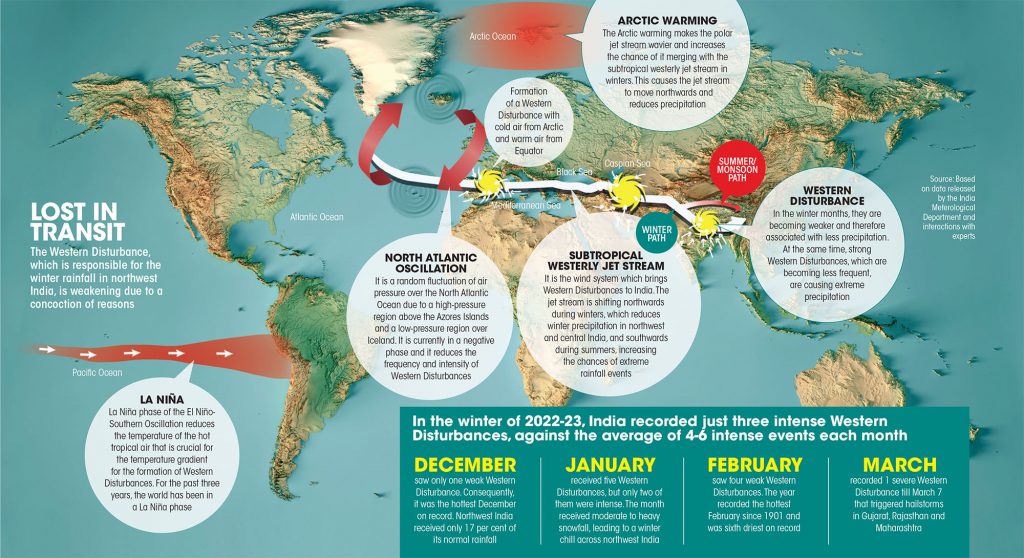News Highlights:
- As per the India Meteorological Department (IMD), the country experienced its hottest-ever December.
- The northwest region, which receives almost 30 per cent of its annual rainfall in the winter season, saw an 83 per cent rainfall deficit.
Key Takeaway:
- The reason for the abnormal winter seasons since 2020-21 lies in the changing character of the Western Disturbances.
- It is a series of cyclonic storms originating in the Mediterranean region and travelling over 9,000 km to bring winter rains to northwest India.
Western Disturbances
- About
- A western disturbance is an extratropical storm originating in the Mediterranean region that brings sudden winter rain to the northwestern parts of the Indian subcontinent.
- They are labelled as an extra-tropical storm originating in the Mediterranean, an area of low pressure that brings sudden showers, snow, and fog in northwest India.
- In the term “extra-tropical storm”, storm refers to low pressure. “Extra-tropical” means outside the tropics. As Western Disturbances(WD) originate outside the tropical region, the word “extra-tropical” has been associated with them.
- It is a non-monsoonal precipitation pattern driven by the westerlies.
- Origin and Character:
- The moisture in these storms usually originates over the Mediterranean, Caspian, and Black Seas.
- Extratropical storms are global phenomena with moisture usually carried in the upper atmosphere, unlike their tropical counterparts where the moisture is carried in the lower atmosphere.
- In the case of the Indian subcontinent, moisture is sometimes shed as rain when the storm system encounters the Himalayas.
- Western disturbances are more frequent and strong in the winter season.
- Path of western disturbance:
- Western Disturbance collects moisture from the Mediterranean Sea, Black Sea and Caspian Sea and traverses over Iran and Afghanistan before hitting the western Himalayas.
- Strong Western Disturbances reach the central and eastern Himalayas and cause rain and snow in Nepal and northeast India.
- Impact:
- Western disturbances, specifically the ones in winter, bring moderate to heavy rain in low-lying areas and heavy snow to mountainous areas of the Indian Subcontinent.
- They cause most winter and pre-monsoon season rainfall across northwest India.
- An average of four to five western disturbances form during the winter season.
- Its significance
- Precipitation during the winter season has great importance in agriculture, particularly for the rabi crops.
- Wheat, among them, is one of the most important crops, which helps to meet India’s food security.

Effects of Western Disturbances in India:
- Agriculture:
- They are vital for the growth of Rabi crops that grow in the winter, such as locally produced wheat.
- One of the reasons this storm is associated with agriculture is that rainfall dictates the fertility and compatibility of soil for crop growth.
- Soil erosion:
- The western disturbances are not always a blessing since it also causes a lot of soil erosion.
- Since the rainfalls are scattered, and the density is quite high, it often results in the topmost layer of the earth getting washed away in the regions of Northern India.
- Higher night temperatures:
- They are also responsible for prolonged cloudy skies and higher night temperatures.
- Crop damage:
- In the case of very heavy rainfall, significant crop damage is also observed, especially with the formation of thick fog and mist.
- Landslides:
- The heavy downpour also results in severe landslides and even avalanches in the region.
Pic Courtesy: Down To Earth
Content Source: Down To Earth



